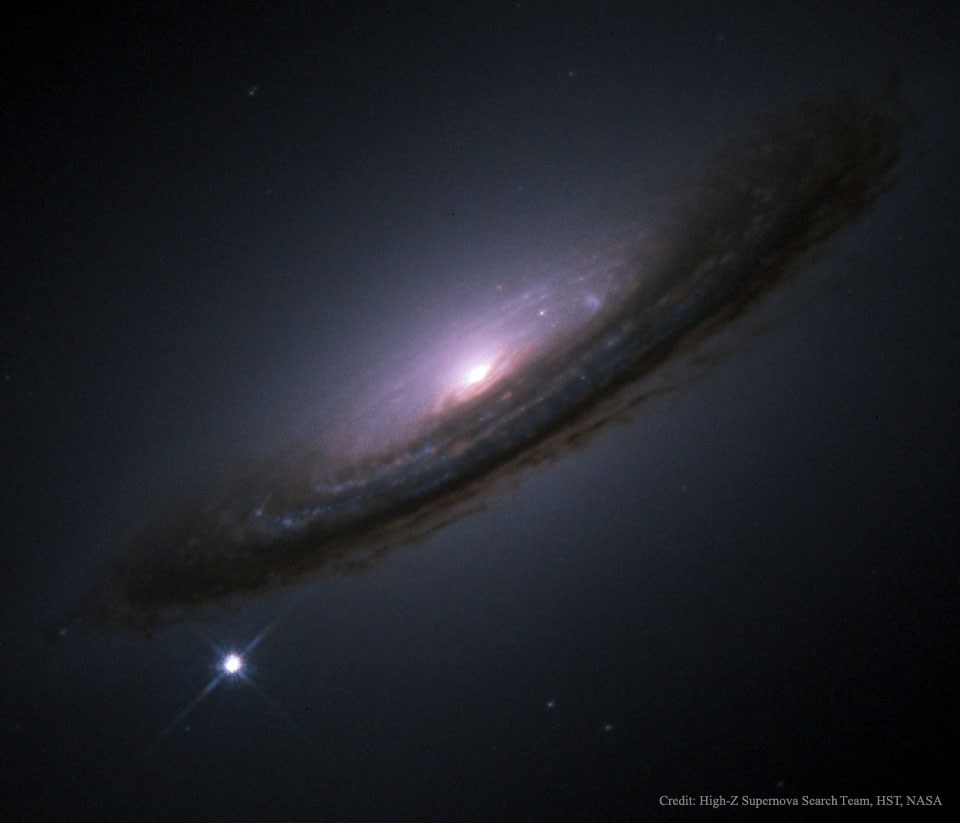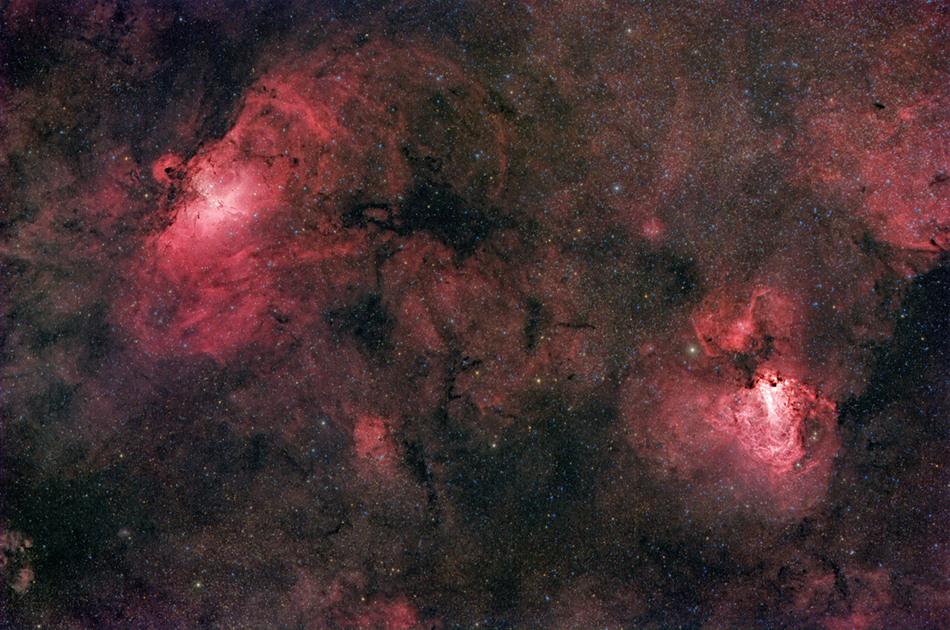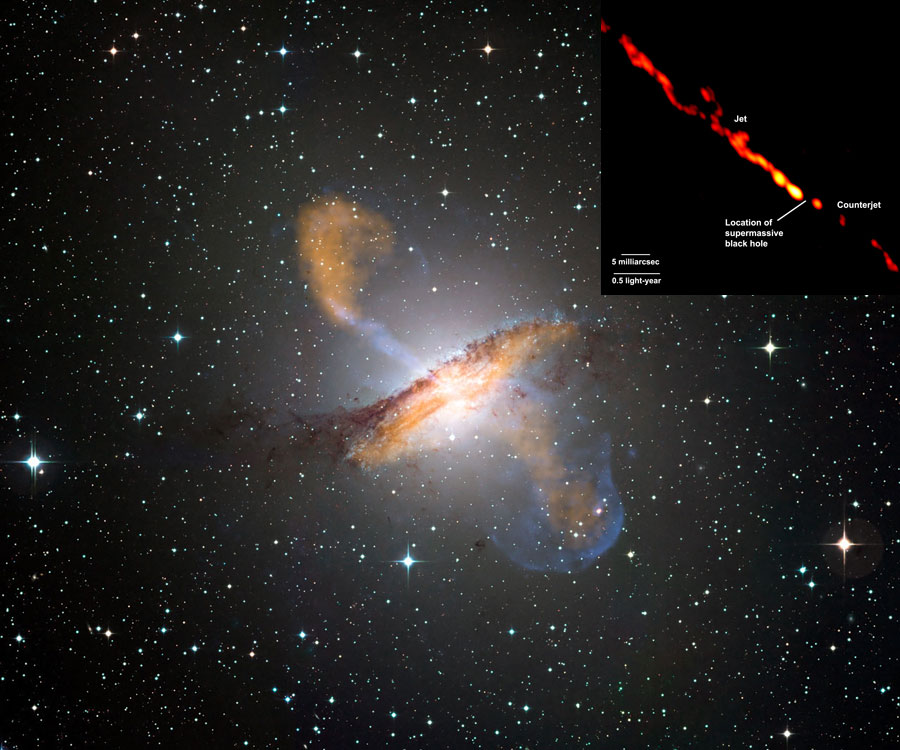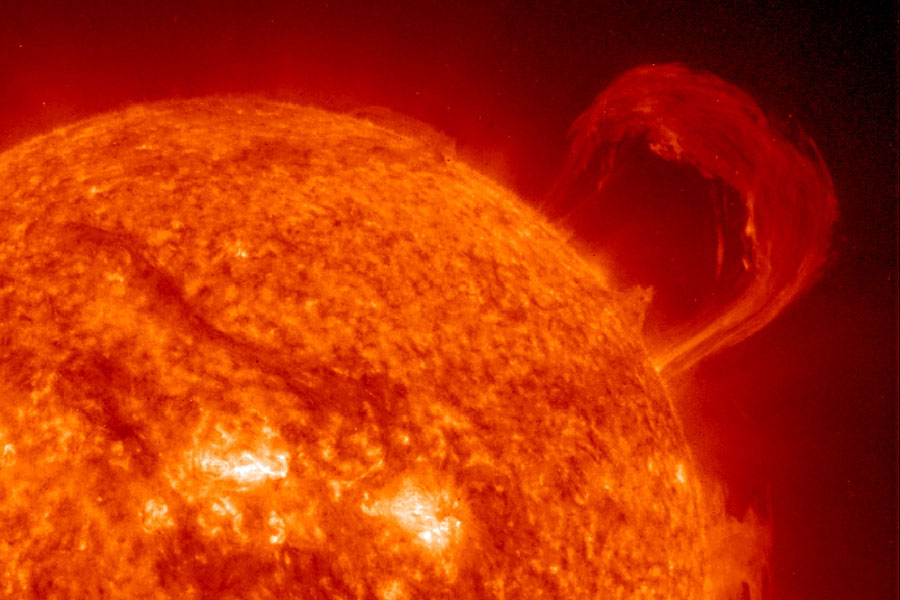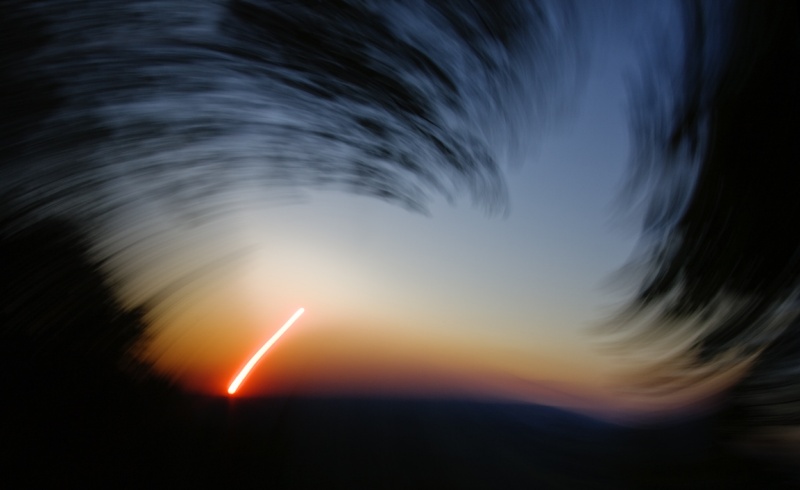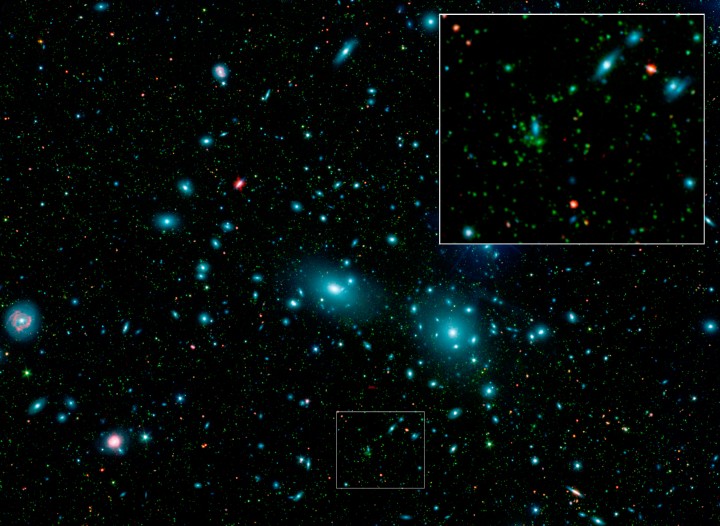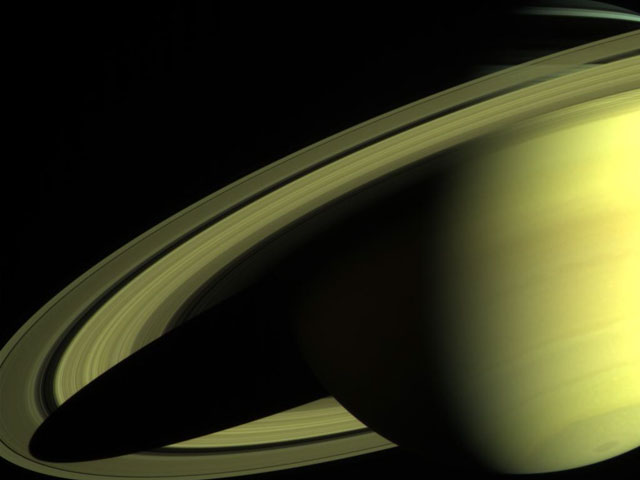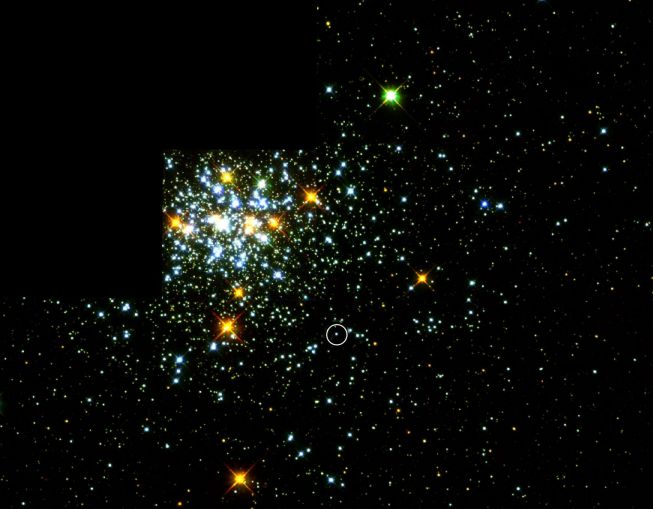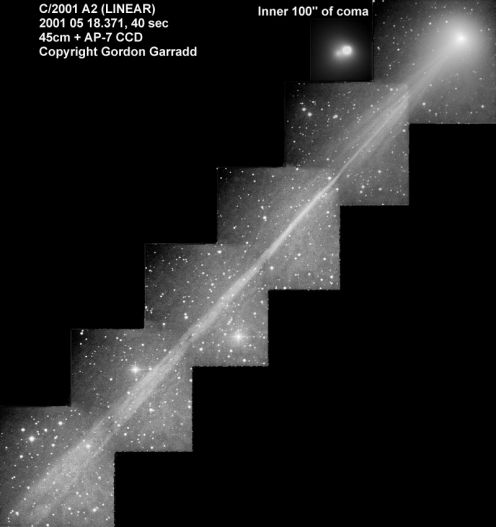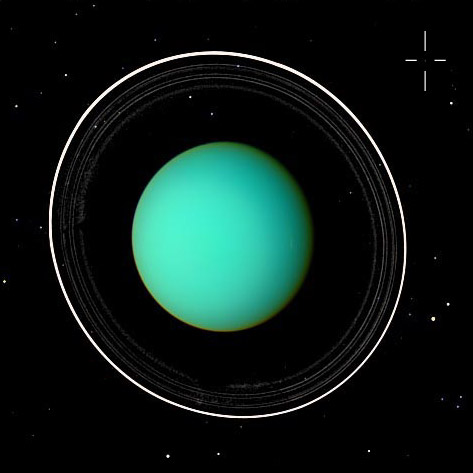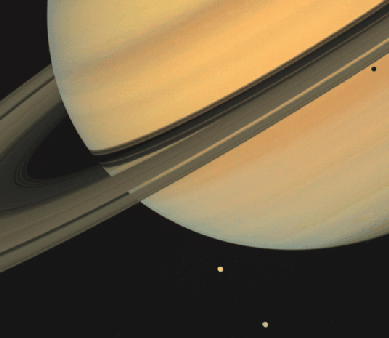| << Previous | Index | Next >> |
2015 Long ago, far away, a star exploded. Supernova 1994D, visible as the bright spot on the lower left, occurred in the outskirts of disk galaxy NGC 4526. Supernova 1994D was not of interest for how different it was, but rather for how similar it was to other supernovae. In fact, the light emitted during the weeks after its explosion caused it to be given the familiar designation of a Type Ia supernova. If all Type 1a supernovae have the same intrinsic brightness, then the dimmer a supernova appears, the farther away it must be. By calibrating a precise brightness-distance relation, astronomers are able to estimate not only the expansion rate of the universe (parameterized by the Hubble Constant), but also the geometry of the universe we live in (parameterized by Omega and Lambda). The large number and great distances to supernovae measured over the past few years, when combined with other observations, are interpreted as indicating that we live in a previously unexpected universe.
2014 This clear night skyscape captures the colorful glow of aurora australis, the southern lights, just outside the port city of Hobart, Tasmania, Australia, planet Earth. As if staring into the dreamlike scene, the Tasmanian Earth Resources Satellite Station poses in the center, illuminated by nearby city lights. Used to receive data from spacebased Earth observing instruments, including NASA's MODIS and SeaWiFS, the station was decommissioned in 2011 and dismantled only recently, shortly after the picture was taken on April 30. Still shining in southern skies though, the central bulge of our Milky Way galaxy and two bright satellite galaxies the Large and Small Magellanic Clouds appear in the frame. The Small Magellanic Cloud shines through the fainter red auroral band.
2013 The Eagle Nebula and the Swan Nebula span this broad starscape, a telescopic view of the Sagittarius spiral arm toward the center of our Milky Way galaxy. The Eagle, also known as M16, is left, above center, and the Swan, or M17 at the lower right. The deep, wide-field image shows the cosmic clouds as brighter regions of active star-formation. They lie along the spiral arm suffused with reddish emission charactistic of atomic hydrogen gas, and dusty dark nebulae. In fact, the center of both nebulae are locations of well-known close-up images of star formation from the Hubble Space Telescope. M17, also called the Omega Nebula, is about 5500 light-years away, while M16 is some 6500 light-years distant. In the frame that covers 3 degrees across the sky, the extended wings of the Eagle Nebula are spread over 120 light-years.
2012 Known for its bright ring system and many moons, gas giant Saturn looks strange and unfamiliar in this false-color view from the Cassini spacecraft. In fact, in this Visual and Infrared Mapping Spectrometer (VIMS) mosaic the famous rings are almost invisible, seen edge-on cutting across picture center. The most striking contrast in the image is along the terminator or boundary between night and day. To the right (day side) blue-green hues are visible sunlight reflected from Saturn's cloud tops. But on the left (night side) in the absence of sunlight, the lantern-like glow of infrared radiation from the planet's warm interior silhouettes features at Saturn's deeper cloud levels. The infrared glow also shines from the broad shadows of Saturn's rings sweeping across the planet's upper hemisphere.
2011
2010 While cruising around Saturn, be on the lookout for picturesque juxtapositions of moons and rings. Another striking alignment occurred last March in the view of humanity's Saturn-orbiting Cassini spacecraft. Rhea, one of Saturn's larger moons, was caught passing Epimetheus, one of Saturn's smaller moons. Epimetheus, as pictured above, is actually well behind the heavily cratered Rhea. Further back, several of the complex rings of Saturn can be seen crossing the image horizontally. Behind both the moons and rings is giant Saturn itself, showing expansive but featureless clouds in the green light where the above image was taken. The Cassini mission around Saturn has now been extended to 2017 to better study the complex planetary system as its season changes from equinox to solstice.
2009 How can gas float above the Sun? Twisted magnetic fields arching from the solar surface can trap ionized gas, suspending it in huge looping structures. These majestic plasma arches are seen as prominences above the solar limb. In 1999 September, this dramatic and detailed image was recorded by the EIT experiment on board the space-based SOHO observatory in the light emitted by ionized Helium. It shows hot plasma escaping into space as a fiery prominence breaks free from magnetic confinement a hundred thousand kilometers above the Sun. These awesome events bear watching as they can affect communications and power systems over 100 million kilometers away on Planet Earth. Recently, our Sun has been unusually quiet.
2008 Each day on planet Earth can have a dramatic ending as the Sun sets below the colorful western horizon. Often inspiring, or offering a moment for contemplation, a sunset is perhaps the single most photographed celestial event. Did you recognize this as a picture of one? The image actually is a single exposure of the setting Sun recorded near Wasserberg, Germany on May 11. To create the uncommon sunset view the photographer used a digital camera and a zoom lens (a lens with an adjustable focal length). During the 1/6 second long exposure he smoothly changed the focal length while simultaneously rotating the camera, altering the image scale and orientation. The result transforms an objective depiction of nature into an artistic abstraction.
2007
2006 Scheduled for launch in 2007, the Gamma-ray Large Area Space Telescope (GLAST) will explore the Universe in gamma-rays, the most energetic form of light. To get ready, consider this dynamic gamma-ray sky animation - constructed from simulating the first 55 days (seen above at one frame per day) of GLAST observations of cosmic gamma-ray sources. The all-sky view is projected in an astronomical (RA-Dec) coordinate system that shows the plane of our Milky Way Galaxy as a broad U-shape, with the center of the galaxy toward the right. So what shines in this gamma-ray sky? Besides the diffuse Milky Way glow, astronomers testing their skills on the simulated data have found flaring active galaxies, pulsars, gamma-ray bursts, the flaring Sun, and of course, the gamma-ray Moon.
2005 Unspeakable beauty and unimaginable bedlam can be found together in the Trifid Nebula. Also known as M20, this photogenic nebula is visible with good binoculars towards the constellation of Sagittarius. The energetic processes of star formation create not only the colors but the chaos. The red-glowing gas results from high-energy starlight striking interstellar hydrogen gas. The dark dust filaments that lace M20 were created in the atmospheres of cool giant stars and in the debris from supernovae explosions. Which bright young stars light up the blue reflection nebula is still being investigated. The light from M20 we see today left perhaps 3000 years ago, although the exact distance remains unknown. Light takes about 50 years to cross M20.
2004 Next stop: Saturn. The Cassini-Huygens spacecraft is approaching Saturn and will fire its engines to break into orbit around the ringed giant on July 1. The robot spacecraft was launched in 1997 and rounded Jupiter in 2001. As Cassini orbits Saturn over the next four years, it will swoop past many of Saturn's moons for unprecedented close-ups and even drop a probe onto Titan. Pictured above, Cassini imaged Saturn two weeks ago as it closed to only 24 million kilometers out. Visible are complex cloud patterns, thousands of rings, a shadow angle not visible from Earth, and a moon (if you can find it).
2003 This is NGC 1818, a youthful, glittering cluster of 20,000 stars residing in the Large Magellanic Cloud, 180,000 light-years away. Pick a star. Any star. Astronomers might pick the unassuming bluish-white one (circled) which appears to be a hot newly formed white dwarf star. What makes it so interesting? The standard astronomical wisdom suggests that stars over 5 times as massive as the sun rapidly exhaust their nuclear fuel and end their lives in a spectacular supernova explosion. With less than this critical mass they evolve into red giants, pass through a relatively peaceful planetary nebula phase, and calmly fade away as white dwarf stars like this one. Except that as a member of the NGC 1818 cluster, this new white dwarf would have evolved from a red giant star over 7.6 times as massive as the sun -- which should have exploded! Its discovery will likely force astronomers to revise the limiting mass estimate for supernovae upward.
2002 Scroll right and dive into a spectacular canyon on Mars. This daytime infrared view, recently recorded by the THEMIS camera on board the orbiting Mars Odyssey spacecraft, covers a 30 by 175 kilometer swath running along the canyon floor. The north (left) end of the scene is poised at the edge of Candor Chasma, part of the great Valles Marineris canyon system. In all about 4,000 kilometers long and up to 6 kilometers deep, Valles Marineris is roughly five times the size of the Grand Canyon on planet Earth. The THEMIS camera data was recorded in three separate infrared bands and combined to make this striking false-color image. Resulting color differences along this intricate section of martian terrain are attributed to differences in mineralogy, the chemical makeup and structure of the rocks, sediments and surface dust.
2001 Arcing toward southern skies in late March, this faint comet LINEAR - the one officially designated C/2001 A2 (LINEAR) - brightened unexpectedly. The outburst, apparently due to the fragmentation of its nucleus, delighted observers as the comet eventually increased to naked-eye brightness. Comet LINEAR's tail also grew and in this mosaic of images from May 18, astronomer Gordon Garradd has carefully followed the fluorescing filaments of LINEAR's gas tail stretching 1.5 degrees (the width of three full moons) along the anti-sunward direction. The inset close-up near the top clearly shows two bright condensations in the cometary coma, indicating the presence of a split nucleus. This comet LINEAR made its closest approach to the Sun on May 24. Still showing off for southern skygazers at about 5th magnitude, it will become more easily visible for northern observers by late June.
2000 Did you ever have a day where everything got turned around and you just couldn't tell which way was up? Fortunately, this didn't happen to astronaut James S. Voss on May 21, who spent six hours preparing to fix and upgrade the International Space Station. Voss is shown above anchored in the clutches of Space Shuttle Atlantis' mechanical arm, maneuvering outside the shuttle's cargo bay high above planet Earth. This space walk was the 85th in US history and the fifth dedicated to the construction of the International Space Station. The STS-101 mission returned early Monday morning after successfully replacing the station's batteries, lifting the station into a higher orbit, and replenishing needed supplies. In several years, when the International Space Station is complete, a crew of up to seven astronauts will live and work in a volume similar to a 747 jumbo jet.
1999 The discovery was there for the taking. An image of Uranus taken by Voyager 2 as it passed the giant planet 13 years ago apparently recorded a moon that had since gone unnoticed. The image on which Uranus' 18th moon was discovered was freely available from NASA. Erich Karkoschka (U. Arizona) noticed the moon when comparing a 1986 photo to a recent one taken by the Hubble Space Telescope. The newly identified moon is hard to see but marked in the above photograph. Also visible are many other Uranian moons and background stars. The moon is the 18th known around Uranus, tying it with Saturn for the most around any planet.
1998 Phobos is doomed. Mars, the red planet named for the Roman god of war, has two tiny moons, Phobos and Deimos, whose names are derived from the Greek for Fear and Panic. These Martian moons may well be captured asteroids originating in the asteroid belt between Mars and Jupiter or perhaps from even more distant reaches of the Solar System. In this 1977 Viking orbiter image, the largest moon, Phobos, is seen to be a heavily cratered asteroid-like object. It is about 17 miles across and zips through the Martian sky completing an orbit in less than 8 hours. Phobos orbits so close to Mars, (about 3,600 miles above the surface compared to 250,000 miles for our Moon) that gravitational tidal forces are dragging it down. In 100 million years or so it should crash into the surface or be shattered by stress caused by the relentless tidal forces, the debris forming a ring around Mars.
1997 Saturn and two of its larger moons - Tethys and Dione - were photographed by the Voyager 1 spacecraft which flew by the planet in November of 1980. This picture gives an indication of Saturn's extensive ring system, which can be seen casting a shadow on the planet, as does Tethys. Saturn's rings are composed of many chunks of ice ranging in size from a pebble to a car. The rings have several large gaps, the largest of which is clearly visible in the picture and is named the Cassini Division, after its discoverer. Saturn appears brighter than most stars in the sky, and its rings can be discerned with a small telescope. A new spacecraft - Cassini - will visit Saturn and is currently scheduled for launch later in 1997.
1996 In the Summer of 1054 A.D. Chinese astronomers reported that a star in the constellation of Taurus suddenly became as bright as the full Moon. Fading slowly, it remained visible for over a year. It is now understood that a spectacular supernova explosion - the detonation of a massive star whose remains are now visible as the Crab Nebula- was responsible for the apparition. The core of the star collapsed to form a rotating neutron star or pulsar, one of the most exotic objects known to 20th century astronomy. Like a cosmic lighthouse, the rotating Crab pulsar generates beams of radio, visible, x-ray and gamma-ray energy which, as the name suggests, produce pulses as they sweep across our view. Using a stunning series of visible light images taken with the Hubble Space Telescope (HST), astronomers have recently discovered spectacular pulsar powered motions within the Crab nebula. Highlights of this HST Crab "movie" show wisps of material moving away from the pulsar at half the speed of light, a scintillating halo, and an intense knot of emission dancing, sprite-like, above the pulsar's pole. Only 6 miles wide but more massive than the sun, the pulsar's energy drives the dynamics and emission of the nebula itself which is more than 10 lightyears across. In the HST image above, the pulsar is the left most of the two bright central stars.
| << Previous | Index | Next >> |
